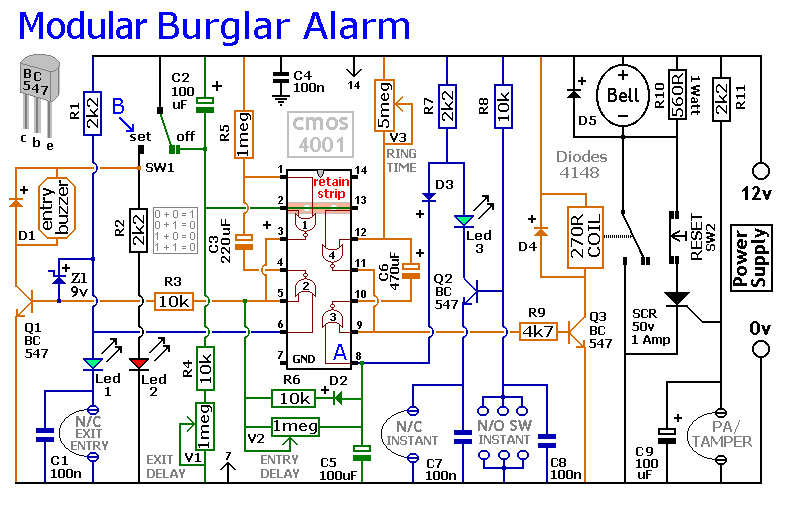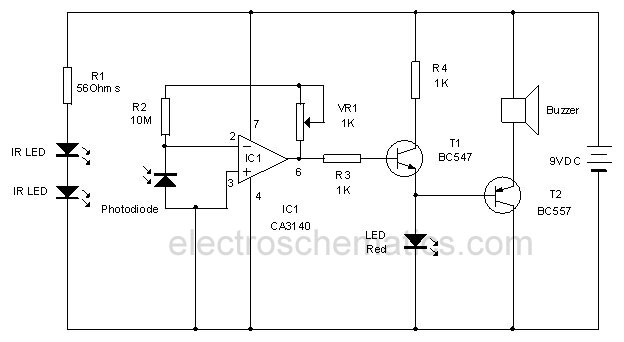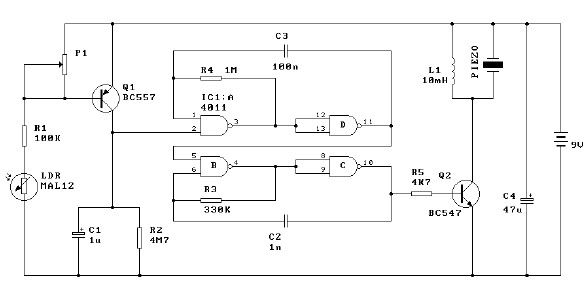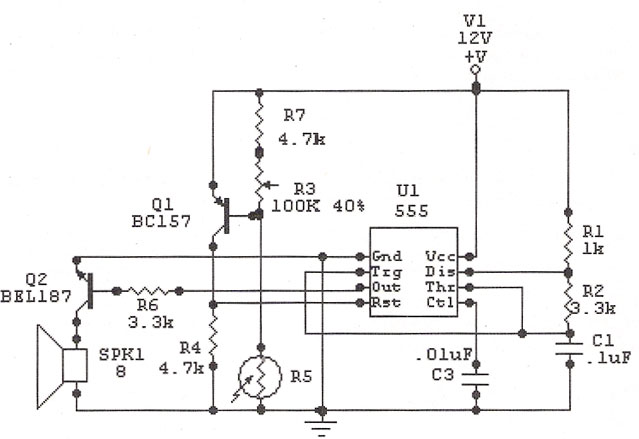
Enhanced Alarm
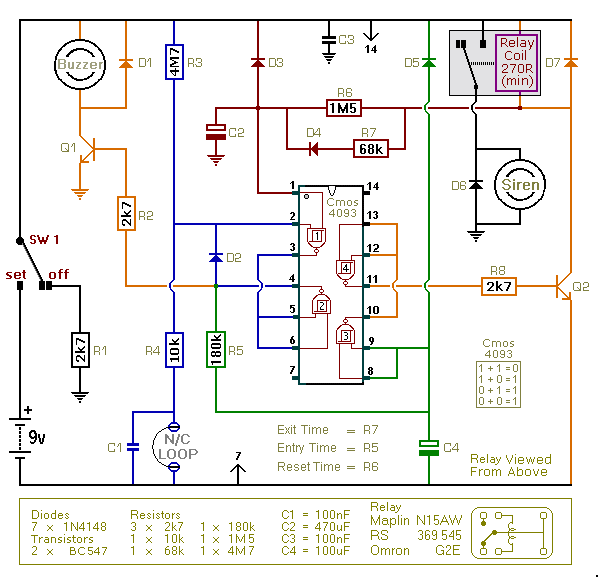
This is an enhanced version of the simple Garage/Shed Alarm. The entry and exit delays have been increased to approximately 30 seconds, and a timed siren cut-off and automatic reset have been added. The LED has been replaced with an entry buzzer, making the new version more widely applicable. The circuit is designed for use with common types of normally-closed input devices such as magnetic reed contacts, microswitches, foil tape, and PIRs. Although it can be powered from mains, its extremely low standby current makes it ideal for battery operation. A 9-volt battery is used in the diagram, but the circuit will function with voltages ranging from 5 to 15 volts. It is important to select a relay, buzzer, and siren suitable for the chosen voltage. To set the alarm, switch SW1 to the "set" position, providing approximately 30 seconds to exit the building. When returning and opening the door, the buzzer will sound, indicating that there are about 30 seconds to move SW1 to the "off" position. If this is not done, the relay will energize and the siren will activate. After about 10 minutes, the alarm will attempt to reset itself. If the trigger circuit has been restored, the reset will be successful; otherwise, the alarm will reactivate. The circuit will continue to attempt resetting every five minutes until the trigger circuit is restored or the alarm is turned off. If a 1.5 MΩ resistor is unavailable, a 1 MΩ and a 470 kΩ resistor can be connected in series as an alternative. Due to manufacturing tolerances, the precise length of any delay is dependent on the characteristics of the actual components used. However, by adjusting the values of R5, R6, and R7, the entry, reset, and exit times can be modified to meet specific requirements; increasing these values will extend the time, while decreasing them will shorten it. The circuit operates optimally with a CMOS 4093, which is the Schmitt-Trigger version of the 4011. Although the circuit is compatible with the 4011, it does not perform as well due to the lack of hysteresis. Supporting materials include an explanation of hysteresis, a complete circuit description, a parts list, a step-by-step construction guide, and additional information.
The enhanced Garage/Shed Alarm circuit is designed to provide an effective security solution for garages and sheds, leveraging modern electronic components to ensure reliability and ease of use. The integration of a timed siren cut-off and automatic reset feature enhances its functionality, allowing for a user-friendly experience. The use of normally-closed input devices ensures compatibility with a wide range of sensors, making the alarm adaptable to various security needs.
The power supply versatility of the circuit allows it to operate efficiently on different voltage levels, catering to both mains and battery-powered applications. The choice of a 9-volt battery as a standard in the schematic exemplifies the design's intent for portability and low power consumption. The alarm’s operational logic is straightforward, with clear indications through the buzzer when the system is armed or triggered.
The design incorporates a relay that plays a crucial role in activating the siren upon alarm trigger. The timed reset functionality is particularly beneficial in preventing false alarms, ensuring that the system remains functional without requiring constant manual intervention. The circuit's ability to self-reset every five minutes if the trigger is not restored adds a layer of resilience, providing ongoing protection.
The choice of the CMOS 4093 is significant due to its superior performance characteristics, specifically the hysteresis property that enhances noise immunity and stability in the circuit's operation. This is particularly important in environments where electrical interference may be present. The ability to adjust the timing components (R5, R6, and R7) allows for fine-tuning of the alarm's response times, making it customizable to the user's specific requirements.
Overall, this alarm circuit represents a well-thought-out design that balances functionality, adaptability, and ease of use, making it an excellent choice for enhancing security in various applications. The inclusion of comprehensive support materials further aids users in understanding and constructing the circuit effectively.This is an enhanced version of the simple Garage/Shed Alarm. The Entry and Exit delays have been increased to about 30-seconds - and I`ve added a timed Siren cut-off and automatic Reset. I`ve also replaced the LED with an entry Buzzer. These enhancements mean that the new version will have a much wider application. The circuit is designed to be u sed with the usual types of normally-closed input devices such as - magnetic-reed contacts - micro switches - foil tape - and PIRs. Although it can be mains powered - the extremely small standby current makes it ideal for battery-powered operation.
I`ve used a 9-volt battery in the diagram - but the circuit will work at anything from 5 to 15-volts. Just choose a Relay, Buzzer and Siren suitable for the voltage you want to use. To set the alarm - move SW1 to the "set" position. You now have about 30 seconds to leave the building. When you return and open the door - the Buzzer will sound. You then have about 30 seconds to move SW1 to the "off" position. If you fail to do so - the relay will energize and the Siren will sound. After about 10-minutes the alarm will attempt to reset itself. If the trigger circuit has been restored - the attempt will be successful. But if the loop is still open - the attempt will fail - and the alarm will re-activate. The circuit will go on trying to reset itself about every five-minutes thereafter - until the trigger circuit has been restored - or the alarm is switched off.
If a 1M5 resistor is not available - use a 1M and a 470k resistor connected in series. That`s what I did. Because of manufacturing tolerances - the precise length of any delay depends on the characteristics of the actual components you`ve used in your circuit. But by altering the values of R5, R6 & R7 you can adjust the Entry, Reset & Exit times to suit your requirements.
Increasing the values increases the time - and vice-versa. The circuit works best with a Cmos 4093. The Cmos 4093 is the Schmidt-Trigger version of the 4011. While its logic is identical to that of the 4011 - what makes it different is a property known as "Hysteresis". The circuit will work with a 4011. But - because the 4011 does not posses hysteresis - it will not work as well. The Support Material includes an explanation of hysteresis - a complete circuit description - a parts list - a step-by-step guide to construction - and more.
🔗 External reference
The enhanced Garage/Shed Alarm circuit is designed to provide an effective security solution for garages and sheds, leveraging modern electronic components to ensure reliability and ease of use. The integration of a timed siren cut-off and automatic reset feature enhances its functionality, allowing for a user-friendly experience. The use of normally-closed input devices ensures compatibility with a wide range of sensors, making the alarm adaptable to various security needs.
The power supply versatility of the circuit allows it to operate efficiently on different voltage levels, catering to both mains and battery-powered applications. The choice of a 9-volt battery as a standard in the schematic exemplifies the design's intent for portability and low power consumption. The alarm’s operational logic is straightforward, with clear indications through the buzzer when the system is armed or triggered.
The design incorporates a relay that plays a crucial role in activating the siren upon alarm trigger. The timed reset functionality is particularly beneficial in preventing false alarms, ensuring that the system remains functional without requiring constant manual intervention. The circuit's ability to self-reset every five minutes if the trigger is not restored adds a layer of resilience, providing ongoing protection.
The choice of the CMOS 4093 is significant due to its superior performance characteristics, specifically the hysteresis property that enhances noise immunity and stability in the circuit's operation. This is particularly important in environments where electrical interference may be present. The ability to adjust the timing components (R5, R6, and R7) allows for fine-tuning of the alarm's response times, making it customizable to the user's specific requirements.
Overall, this alarm circuit represents a well-thought-out design that balances functionality, adaptability, and ease of use, making it an excellent choice for enhancing security in various applications. The inclusion of comprehensive support materials further aids users in understanding and constructing the circuit effectively.This is an enhanced version of the simple Garage/Shed Alarm. The Entry and Exit delays have been increased to about 30-seconds - and I`ve added a timed Siren cut-off and automatic Reset. I`ve also replaced the LED with an entry Buzzer. These enhancements mean that the new version will have a much wider application. The circuit is designed to be u sed with the usual types of normally-closed input devices such as - magnetic-reed contacts - micro switches - foil tape - and PIRs. Although it can be mains powered - the extremely small standby current makes it ideal for battery-powered operation.
I`ve used a 9-volt battery in the diagram - but the circuit will work at anything from 5 to 15-volts. Just choose a Relay, Buzzer and Siren suitable for the voltage you want to use. To set the alarm - move SW1 to the "set" position. You now have about 30 seconds to leave the building. When you return and open the door - the Buzzer will sound. You then have about 30 seconds to move SW1 to the "off" position. If you fail to do so - the relay will energize and the Siren will sound. After about 10-minutes the alarm will attempt to reset itself. If the trigger circuit has been restored - the attempt will be successful. But if the loop is still open - the attempt will fail - and the alarm will re-activate. The circuit will go on trying to reset itself about every five-minutes thereafter - until the trigger circuit has been restored - or the alarm is switched off.
If a 1M5 resistor is not available - use a 1M and a 470k resistor connected in series. That`s what I did. Because of manufacturing tolerances - the precise length of any delay depends on the characteristics of the actual components you`ve used in your circuit. But by altering the values of R5, R6 & R7 you can adjust the Entry, Reset & Exit times to suit your requirements.
Increasing the values increases the time - and vice-versa. The circuit works best with a Cmos 4093. The Cmos 4093 is the Schmidt-Trigger version of the 4011. While its logic is identical to that of the 4011 - what makes it different is a property known as "Hysteresis". The circuit will work with a 4011. But - because the 4011 does not posses hysteresis - it will not work as well. The Support Material includes an explanation of hysteresis - a complete circuit description - a parts list - a step-by-step guide to construction - and more.
🔗 External reference
